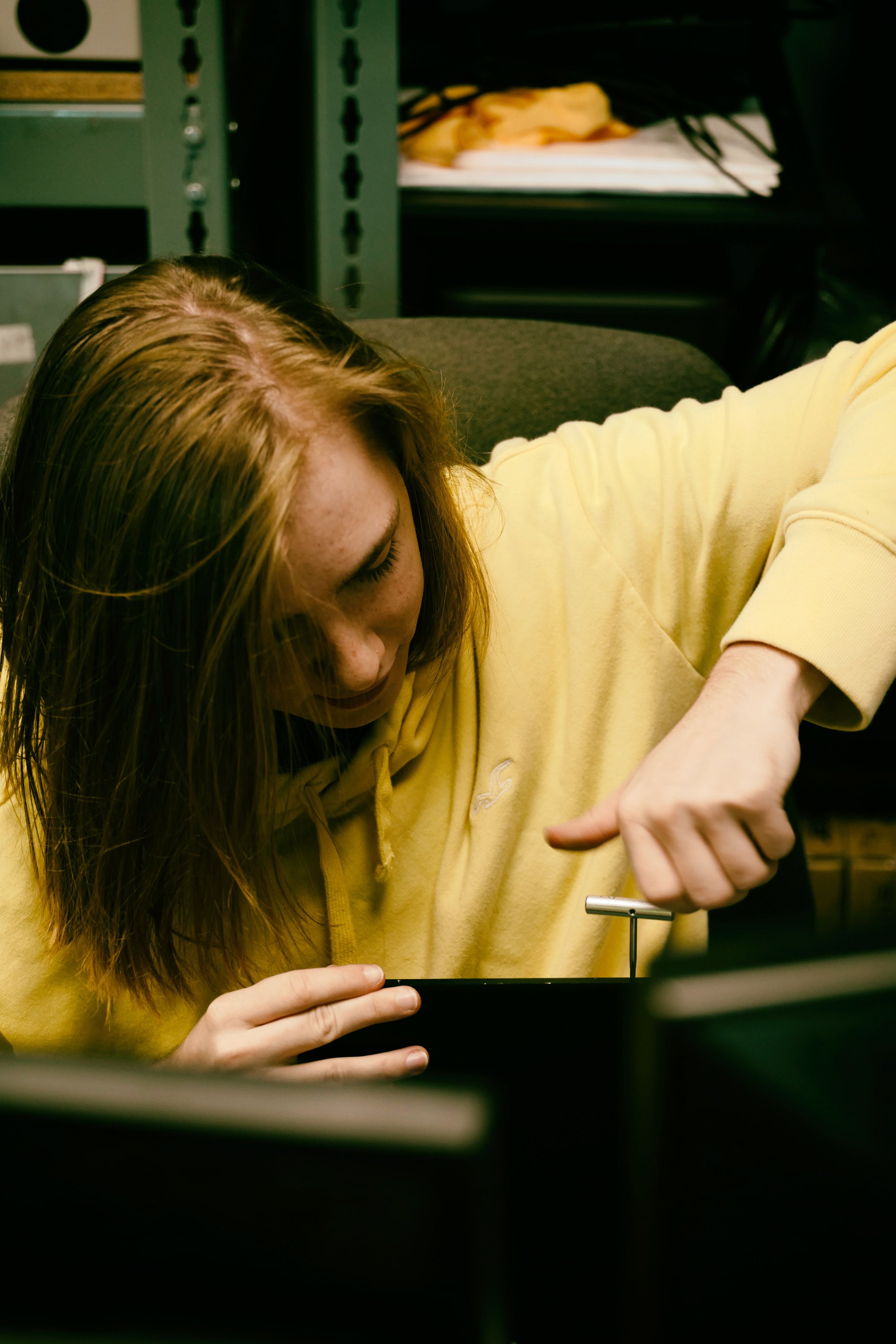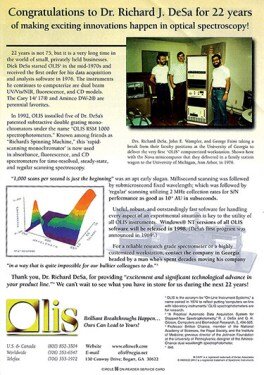Getting The Spectrophotometers To Work
Getting The Spectrophotometers To Work
Blog Article
Spectrophotometers for Beginners
Table of ContentsThe 5-Minute Rule for Uv/vis7 Easy Facts About Uv/vis ShownThe 9-Minute Rule for Uv/visIndicators on Circularly Polarized Luminescence You Should KnowThe Single Strategy To Use For Uv/vis/nirAn Unbiased View of Uv/visThe Ultimate Guide To Uv/visLittle Known Questions About Circular Dichroism.6 Easy Facts About Uv/vis Explained7 Easy Facts About Uv/vis/nir ExplainedHow Circularly Polarized Luminescence can Save You Time, Stress, and Money.The Facts About Uv/vis/nir UncoveredThe 5-Minute Rule for Uv/vis/nir
It is then scanned through the sample and the recommendation solutions. Fractions of the incident wavelengths are transmitted through, or shown from, the sample and the recommendation. The resultant light strikes the photodetector device, which compares the relative intensity of the two beams. Electronic circuits convert the relative currents into direct transmission portions and/or absorbance/concentration values.The transmission of a referral substance is set as a baseline (information) worth, so the transmission of all other compounds are tape-recorded relative to the preliminary "zeroed" compound. The spectrophotometer then converts the transmission ratio into 'absorbency', the concentration of particular components of the test sample relative to the initial compound.
Considering that samples in these applications are not readily available in big amounts, they are especially suited to being examined in this non-destructive technique. In addition, precious sample can be saved by making use of a micro-volume platform where just 1u, L of sample is required for total analyses. A quick description of the treatment of spectrophotometry includes comparing the absorbency of a blank sample that does not consist of a colored compound to a sample which contains a colored substance.
The 25-Second Trick For Circularly Polarized Luminescence
In biochemical experiments, a chemical and/or physical property is chosen and the treatment that is used is specific to that home in order to derive more information about the sample, such as the quantity, pureness, enzyme activity, etc. Spectrophotometry can be utilized for a variety of strategies such as identifying ideal wavelength absorbance of samples, figuring out optimum p, H for absorbance of samples, identifying concentrations of unknown samples, and identifying the p, Ka of different samples.: 21119 Spectrophotometry is also a useful procedure for protein purification and can likewise be used as a technique to develop optical assays of a compound.
It is possible to understand the concentrations of a 2 part mix utilizing the absorption spectra of the basic services of each part. To do this, it is necessary to understand the termination coefficient of this mixture at 2 wave lengths and the extinction coefficients of solutions which contain the recognized weights of the 2 elements.

What Does Uv/vis/nir Do?
A lot of spectrophotometers are used in the UV and noticeable regions of the spectrum, and a few of these instruments likewise run into the near-infrared Region. The concentration of a protein can be estimated by measuring the OD at 280 nm due to the existence of tryptophan, tyrosine and phenylalanine (http://www.askmap.net/location/6824320/united-states/olis-clarity).
This approach requires a spectrophotometer capable of determining in the UV area with quartz cuvettes.: 135 Ultraviolet-visible (UV-vis) spectroscopy includes energy levels that delight electronic shifts. Absorption of UV-vis light excites particles that are in ground-states to their excited-states.
20. 8 O.D. Ink makers, printing business, fabrics suppliers, and much more, need the data offered through colorimetry. They take readings in the area of every 520 nanometers along the noticeable region, and produce a spectral reflectance curve or an information stream for alternative presentations. These curves can be utilized to evaluate a new batch of colorant to check if it makes a match to requirements, e.
Circular Dichroism Can Be Fun For Anyone
Traditional noticeable region spectrophotometers can not spot if a colorant or the base material has fluorescence. This can make it hard to manage color problems if for instance several of the printing inks is fluorescent. Where a colorant includes fluorescence, a bi-spectral fluorescent spectrophotometer is utilized (https://pagespeed.web.dev/analysis/https-olisclarity-com/ft59obxjpp?form_factor=mobile). There are two significant setups for visual spectrum spectrophotometers, d/8 (spherical) and 0/45.
Scientists use this instrument to measure the amount of substances in a sample. In the case of printing measurements two alternative settings are frequently utilized- without/with uv filter to control much better the impact of uv brighteners within the paper stock.
Facts About Circular Dichroism Uncovered
Some applications need little volume measurements which can be performed with micro-volume platforms. As explained in the applications area, spectrophotometry can be used in both qualitative and quantitative analysis of DNA, RNA, and proteins. Qualitative analysis can be utilized and spectrophotometers are utilized to tape-record spectra of compounds by scanning broad wavelength areas to determine the absorbance homes (the intensity of the color) of the substance at each wavelength.

Uv/vis/nir Things To Know Before You Get This
One major aspect is the type of photosensors that are offered for different spectral areas, however infrared measurement is also difficult because essentially whatever gives off IR as thermal radiation, especially at wavelengths beyond about 5 m. Another complication is that many materials such as glass and plastic absorb infrared, making it incompatible as an optical medium.
Samples for IR spectrophotometry may be smeared in between 2 discs of potassium bromide or ground with potassium bromide and pushed into a pellet. Where liquid solutions are to be determined, insoluble silver chloride is utilized to build the cell. Spectroradiometers, which run almost like the visible region spectrophotometers, are developed to measure the spectral density of illuminants. 2013. p. 13. Allen, DW; Cooksey, C; Tsai, BK (Nov 13, 2009). "Spectrophotometry". Retrieved Dec 23, 2018. Ninfa AJ, Ballou DP, Benore M (2010 ). Fundamental Laboratory Approaches for Biochemistry and Biotechnology (2nd ed.). Hoboken: Wiley & Sons. ISBN 9780470087664. OCLC 488246403. Schwedt G (1997 ). The essential guide to analytical chemistry.
Chichester, NY: Wiley. pp. 1617. ISBN 9780471974123. OCLC 36543293. Ninfa AJ, Ballou DP (2004 ). Basic laboratory methods for biochemistry and biotechnology. Hoboken: Wiley. p. 66. ISBN 9781891786006. OCLC 633862582. Rendina G (1976 ). Philadelphia, PA: W. B. Saunders Company. pp. 46-55. ISBN 0721675506. OCLC 147990. Oke, J. B.; Gunn, J. E.
Not known Factual Statements About Spectrophotometers
"Secondary standard stars for absolute spectrophotometry". right here The Astrophysical Journal. 266: 713. Bibcode:1983 Ap, J..266..713 O. doi:10. 1086/160817. Ishani, G (2006 ). "The very first business UV-vis spectrophotometer". p. 100. Recovered Dec 23, 2018. Simoni, RD; Hill, RL; Vaughan, M; Tabor, H (Dec 5, 2003). "A Timeless Instrument: The Beckman DU Spectrophotometer and Its Innovator, Arnold O.
278 (49 ): e1. doi:. ISSN 1083-351X. Beckman, A. O.; Gallaway, W. S.; Kaye, W.; Ulrich, W. F. (March 1977). "History of spectrophotometry at Beckman Instruments, Inc". Analytical Chemistry. 49 (3 ): 280A300A. doi:10. 1021/ac50011a001. "Hewlett Packard: Substance Recognition with HP 8450 A UV Noticeable Spectrophotometer". Analytical Chemistry. 51 (12 ): 1188A1189A. 1979-10-01.
Ninfa AJ, Ballou DP, Benore M (2015 ). Fundamental Laboratory Techniques for Biochemistry and Biotechnology (3, rev. ed.). circular dichroism. Lab Equipment.
4 Easy Facts About Circular Dichroism Explained
Recovered Jul 4, 2018. Trumbo, Toni A.; Schultz, Emeric; Borland, Michael G.; Pugh, Michael Eugene (April 27, 2013). "Applied Spectrophotometry: Analysis of a Biochemical Mixture". Biochemistry and Molecular Biology Education. 41 (4 ): 24250. doi:10. 1002/bmb. 20694. PMID 23625877. (PDF). www. mt.com. Mettler-Toledo AG, Analytical. 2016. Recovered Dec 23, 2018. Cortez, C.; Szepaniuk, A.; Gomes da Silva, L.
"Checking Out Proteins Filtration Strategies Animations as Tools for the Biochemistry Teaching". Journal of Biochemistry Education. 8 (2 ): 12. doi:. Garrett RH, Grisham CM (2013 ). Biochemistry. Belmont, CA: Cengage. p. 106. ISBN 978-1133106296. OCLC 801650341. Holiday, Ensor Roslyn (May 27, 1936). "Spectrophotometry of proteins". Biochemical Journal. 30 (10 ): 17951803. doi:10. 1042/bj0301795.
PMID 16746224. Hermannsson, Ptur G.; Vannahme, Christoph; Smith, Cameron L. C.; Srensen, Kristian T.; Kristensen, Anders (2015 ). "Refractive index dispersion picking up utilizing a selection of photonic crystal resonant reflectors". Applied Physics Letters. 107 (6 ): 061101. Bibcode:2015 Ap, Ph, L. 107f1101H. doi:10. 1063/1. 4928548. S2CID 62897708. Mavrodineanu R, Schultz JI, Menis O, eds.
The Ultimate Guide To Uv/vis
U.S. Department of Commerce National Bureau of Standards special publication; 378. Washington, D.C.: U.S. National Bureau of Standards. p. 2. OCLC 920079.
The procedure begins with a regulated source of light that illuminates the analyzed sample. In the case of reflection, as this light interacts with the sample, some is taken in or given off. The released light journeys to the detector, which is evaluated, quantified, and presented as industry-standard color scales and indices.
Industry governing bodies usually specify specific metrics for specific items, such as Tomato and Coffee indices. The simplified math looks like this: Where R is the reflection coefficient. All terms are assessed over the noticeable spectrum from 400 to 700 nm. When it comes to transmission, when the light communicates with the sample, it is either absorbed, shown, or transmitted.
The Best Strategy To Use For Uv/vis/nir
Examples include APHA (American Public Health Association) for watercolor and pureness analysis, ASTM D1500 for petrochemical color analysis, edible oil indices used in food, and color analyses of drinks. All terms are assessed over the visible spectrum from 400 to 700 nm.
Image Credit: Matej Kastelic/ Dr. Arnold J. Beckman and his associates at the National Technologies Laboratories first developed the spectrophotometer in 1940. In 1935 Beckman established the business, and the discovery of the spectrophotometer was their most ground-breaking creation.
6 Easy Facts About Circularly Polarized Luminescence Described
Over time, scientists kept improving the spectrophotometer design to boost its efficiency. The UV abilities of the design B spectrophotometer were improved by replacing the glass prism with a quartz prism.
Typically, a spectrophotometer is made up of 2 instruments, namely, a spectrometer and a photometer. A basic spectrophotometer consists of a light source, a monochromator, a collimator for straight light beam transmission, a cuvette to position a sample, and a photoelectric detector.
Uv/vis/nir Things To Know Before You Buy
There are different types of spectrophotometers in numerous shapes and sizes, each with its own purpose or performance. A spectrophotometer figures out just how much light is reflected by chemical elements. UV/Vis/NIR. It determines the distinction in light strength based upon the overall quantity of light introduced to a sample and the quantity of beam that travels through the sample option
A spectrophotometer is used to identify the concentration of both colorless and colored solutes in an option. This instrument is used to identify the rate of a reaction.
Report this page